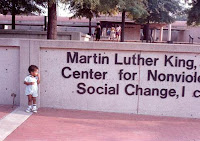 A day does not go by in America in which someone
loses their life over something that is meaningless… and by gun violence. In so many ways, America has become a “killing
field” where even the innocence and the defenseless become victims to power,
politics and money. Even the once “safe” zones within our society
are no longer barriers against the unthinkable tragedies of what is happening daily
in the streets.
A day does not go by in America in which someone
loses their life over something that is meaningless… and by gun violence. In so many ways, America has become a “killing
field” where even the innocence and the defenseless become victims to power,
politics and money. Even the once “safe” zones within our society
are no longer barriers against the unthinkable tragedies of what is happening daily
in the streets.
Over the years we have
seen a tremendous loss of respect for human life, kindness, decency and laws. In many ways it does not matter anymore to be
a good citizen.
Behind it all, many people and businesses continue
to profit from a gun industry that continues to operate in the mainstream and along
the edges of society. More people are
concerned by how they can profit from an industry that is clearly out of
control… and with no common sense, guilt or shame. It seems
that we have entered into those last days of “perilous times”, and “when people
will be lovers of themselves, lovers of money…” (2 Tim. 3:1-2) and where “For the
love of money is the root of all kinds of evil” (I Tim. 6:10).
Perspective
I left the military in 2002, after being on active
duty during the Persian Gulf era, Bosnia Campaign, and the start of 911. My tours of service included deployments and
tours to Europe, Caribbean and Japan. As
a Chaplain, I served in the Navy, did a tour with the Marine Corp and Coast
Guard. During my time of service I had the
opportunity to work with some of the best men and women our country has, we
served not because of fame and fortune, but because we valued “What Freedom Looks
Like”… and operated with a great sense of pride of living in the greatest
country in the world. We stood the watch and were willing to do whatever it took
to guard those freedoms, not only for ourselves, families, but for other
Americans as well.
Also during this time, I had the privilege and honor
to offer countless prayers, conduct numerous memorial and funerals for the
fallen. From a military point of view, I
have seen death; I know what that looks like… And while in the service, I really
enjoyed helping people, regardless of the situation, backgrounds, race, culture
or religious faith… It was my job and calling… I spend time meeting with the families to
provide comfort, a listing ear, a shoulder to cry upon and a voice in which to
express their feelings.
The
Streets
Today, I continue to fulfill my calling by working
with people in the inner city of Milwaukee… through various churches and
community groups … the context is different than the military… but some of the
realities are the same. In the military
we served to preserve “world peace”… in the streets it is hard to define what
the mission is all about… and it will continue to be hard to find when people
lose a sense of community, value for human life, common sense and a willingness
to work towards solutions to stop the violence.
As the road forward takes shape, it will take a lot of people with courage, good will, common sense, and a calling to make a difference … they must see that the greatness of America far outweighs the lining of pockets at the expense of shattered lives, mental illness and youthful dreams unfulfilled. By the way, I live in Oak Creek, WI, the place of the 2012 Sikh Temple shooting and we know "What It Looks and Feels Like?" Peace...
As the road forward takes shape, it will take a lot of people with courage, good will, common sense, and a calling to make a difference … they must see that the greatness of America far outweighs the lining of pockets at the expense of shattered lives, mental illness and youthful dreams unfulfilled. By the way, I live in Oak Creek, WI, the place of the 2012 Sikh Temple shooting and we know "What It Looks and Feels Like?" Peace...














